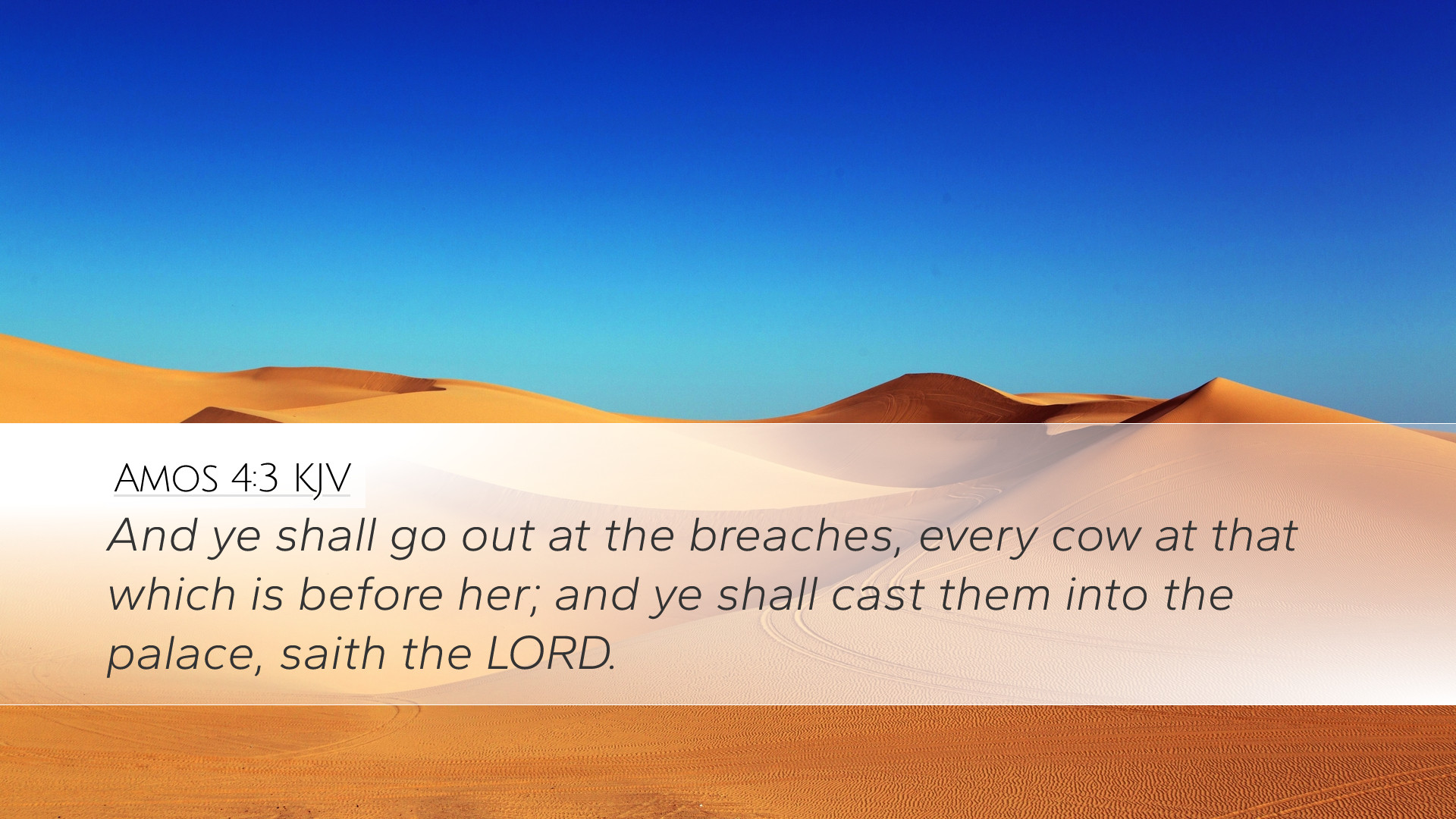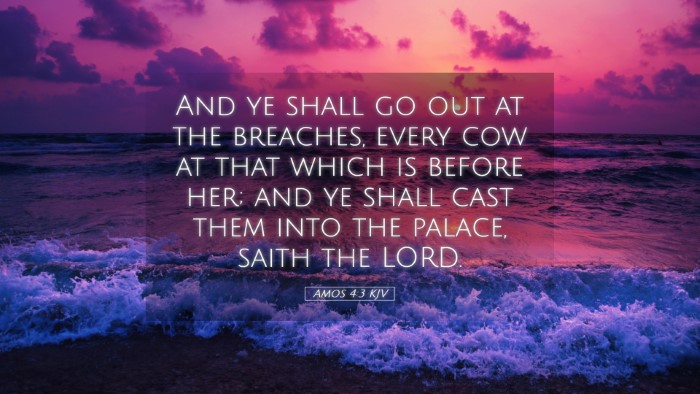Old Testament
Genesis Exodus Leviticus Numbers Deuteronomy Joshua Judges Ruth 1 Samuel 2 Samuel 1 Kings 2 Kings 1 Chronicles 2 Chronicles Ezra Nehemiah Esther Job Psalms Proverbs Ecclesiastes Song of Solomon Isaiah Jeremiah Lamentations Ezekiel Daniel Hosea Joel Amos Obadiah Jonah Micah Nahum Habakkuk Zephaniah Haggai Zechariah MalachiAmos 4:3
Amos 4:3 KJV
And ye shall go out at the breaches, every cow at that which is before her; and ye shall cast them into the palace, saith the LORD.
Amos 4:3 Bible Commentary
Commentary on Amos 4:3
Verse Reference: Amos 4:3 - "And ye shall go out at the breaches, every cow at that which is before her; and ye shall cast them into the palace, saith the Lord." (KJV)
Contextual Background
The book of Amos is a prophetic text that speaks to the people of Israel during a time of economic prosperity but moral decay. Amos, a shepherd called by God, addresses the injustices, idolatry, and spiritual complacency of the Northern Kingdom of Israel. The verse in question, Amos 4:3, occurs within a larger discourse concerning impending judgment due to the nation's sinful practices.
Verse Analysis
In this verse, God, through the prophet Amos, delivers a stark prophetic message about the consequences of Israel's sin.
- Imagery of Breaches: The phrase "ye shall go out at the breaches" suggests a forcible exit, indicating that the people will escape through broken walls or gaps, symbolic of destruction and chaos that will come upon them.
- Cows and Their Movement: The mention of "every cow at that which is before her" may reflect the hurried and confused exodus of people (likened to cows), symbolizing a loss of direction and stability. This portrays the chaotic scene where people are disoriented and fleeing due to calamity.
- Palace Judgment: The reference to being "cast into the palace" can indicate judgment reaching even the highest authorities, suggesting that there will be no escape for the leaders of Israel from divine justice.
Theological Insights
This verse addresses themes of divine judgment, social responsibility, and the reality of God's covenant blessings and curses.
- The Urgency of God's Call: Amos communicates a sense of urgency and inevitability. The breaches indicate that God's protection is withdrawn due to the people's disobedience and sin.
- Divine Sovereignty: The phrase "saith the Lord" emphasizes the authority and sovereignty of God in proclaiming these judgments. It reinforces the idea that God is not only aware of Israel's actions but has decided to respond accordingly.
- The Consequences of Sin: By depicting the consequences of Israel's sin in vivid imagery, Amos cautions readers to consider the gravity of turning away from God's commandments. The chaotic exit symbolizes the disarray that sin brings into the lives of individuals and communities.
Public Domain Commentary Insights
Commentators such as Matthew Henry, Albert Barnes, and Adam Clarke provide valuable perspectives on this verse.
-
Matthew Henry:
Henry emphasizes that the breaches refer to moral and spiritual failures among the people, which lead to God's judgment. He sees the coming calamity as a direct result of their persistent sin and neglect of divine law.
-
Albert Barnes:
Barnes interprets the imagery to reflect the disorder that will ensue when God's judgment falls. He notes that the leaders and people will be powerless to prevent the consequences of their actions, highlighting the futility of idolatry and disobedience.
-
Adam Clarke:
Clarke provides a meticulous exegesis, drawing attention to the societal implications of this prophetic announcement. He suggests that the "palace" signifies the high status of the ruling elite, affirming that all will face God's judgment regardless of their worldly status or power.
Practical Application
This verse has profound implications for contemporary readers, particularly for pastors, students, and scholars engaged in theology and ministry.
- Moral Reflection: It challenges believers to reflect on their personal and communal fidelity to God's commandments and to examine areas where complacency may have led to spiritual decline.
- Call to Repentance: The vivid imagery serves as a call to mark the seriousness of sin and the need for repentance in our lives and churches, reminding us that judgment begins with the house of God (1 Peter 4:17).
- Social Responsibility: The implications of this verse urge us to recognize our role in society. We must advocate for justice, mercy, and righteousness within our communities, acknowledging how collective sin can bring about societal chaos.
- Hope and Redemption: While Amos speaks of judgment, Christians also have the hope of redemption through Christ. This acknowledgment of sin must lead us to the grace found in the Gospel, which provides both a warning and an invitation.


